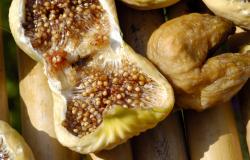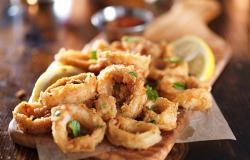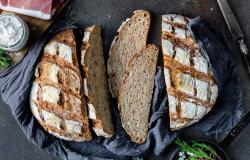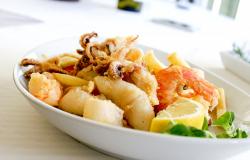Taralli Sugna e Pepe
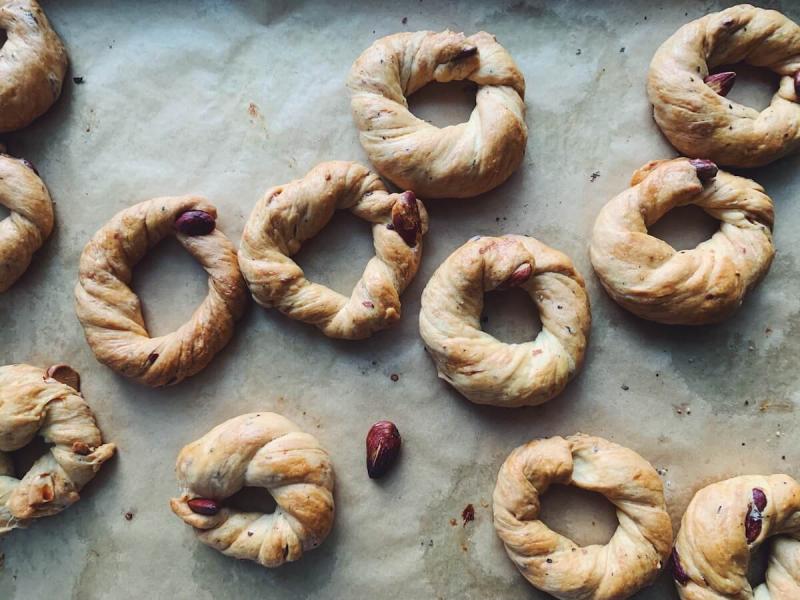
Photo courtesy of Domenica Marchetti
There was a time (not to long ago) when strutto—pork fat, or lard—was the preferred cooking and baking fat in Neapolitan cuisine. Nowadays, many dishes are made with olive oil, deemed to be more healthful. But there are some iconic Neapolitan foods that practically demand to be made the traditional way, using sugna, as pork fat is known in Neapolitan dialect. 'Sfogliatelle—Naples’ iconic many-layered pastry filled with ricotta and semolina—is one example. It’s the sugna that gives the pastry its signature crackling-yet-tender quality.
Another is these savory rings studded with almonds and spiced with a generous amount of black pepper. Taralli sugna e pepe are a classic Neapolitan snack food, for sale by street vendors and bakeries, and perfect with a glass of chilled dry white wine. They can indeed be made with olive oil, as my friend Paola Bacchia does in the recipe from her book Italian Street Food, from which my recipe here is adapted.
But if you can find high-quality pork fat, I recommend using it, for it’s the sugna that gives these rings their characteristic shattering flakiness and redolent bacon undertone. See the note at the end of the recipe for more information on the specific type of pork fat used in the recipe.
1. Cut the almonds in half or chop them into large-ish pieces.
2. Blend the flour and yeast together in the bowl of a stand mixer fitted with the paddle attachment. Pour in the water and add the lard in pieces (or drizzle in the oil) and paddle until combined. Switch to the dough hook and add the salt, pepper, and almonds. Mix until a rough ball dough forms.
3. Tip the dough out onto a lightly floured work surface and knead for several minutes, until it is well-mixed and somewhat smooth and springy (it may remain a bit rough but that’s fine). The almonds will annoyingly try to pop out of the dough; just press them back in as best you can. Transfer the dough to a clean, lightly greased glass or ceramic bowl and cover the bowl with reusable or plastic wrap. Let it rise for an hour (it may or may not double in size).
4. Heat the oven to 350° F (175° C) and position two racks in the oven; one in the upper third and one in the center. Line two rimmed baking sheets with parchment paper.
5. Divide the dough into 24 equal pieces. Work with one piece at a time and cover the rest with a clean kitchen towel. You shouldn’t need to flour the work surface, but if the dough is quite sticky you can sprinkle a small amount on the surface and spread it around. Roll the piece into a rope about 8 or 9 inches (20 to 22 cm) long ~ it will spring back a bit and some almond pieces may escape but keep at it and poke the almond pieces back in (eat the stubborn ones that refuse to stay put). Twist the rope of dough several times, holding it from the ends and twisting in opposite directions so that the twists are visible along its length; then pinch the ends together to form a ring about 2 1/2 inches (6 cm) in diameter. Set the ring on one of the baking sheets. Keep forming the rings; you will end up with 24 rings, 12 per sheet in four rows (three per row).
6. Brush the rings lightly with milk and set them in the oven. Bake for 40 to 50 minutes, switching the positions of the baking sheets about halfway through (the rings on the top rack will brown faster than those on the center rack; switching their positions helps them to brown evenly). The rings are done when they are deep golden-brown and feel fairly light in weight when you (carefully!) pick one up. Remove from the oven and set the sheets on cooling racks. Let the rings cool right on the baking sheets. Store in an airtight container for up to 1 week.
NOTE: Pigs yield different types of fat. The best fat for baking is leaf lard; it comes from around the pig’s kidneys and is soft and spreadable, with a clean pork-free flavor. It can be hard to find, so look for a good, reliable source such as a butcher or farmers’ market vendor. The jar of lard I bought is a combination of leaf lard and fat back (which comes from the backside of the pig) and it worked beautifully in this recipe.
Leaf lard can be stored in a tightly lidded container in the refrigerator for about a month (though mine lasted well longer than that!). For longer keeping, store it in the freezer.
